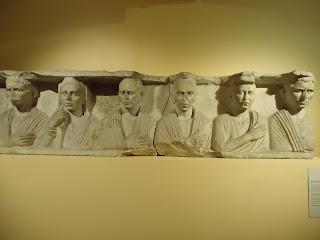I failed to post the last 2 days in no small part because of the overwhelming number of photos taken. Sunday was the Acropolis & South Slope, today was Piraeus, Agora, Roman Agora and Hadrian's Library. The trip to the Piraeus museum to see an inscription was mildly painful--the stone is broken in just the wrong place so that only the final 2 letters of the word I was looking at remain. And it is a deep break with no recoverable traces of letter carving. I will need to figure out some other way to prove the restoration. On the positive side,the Piraeus Archaeological Museum has some absolutely beautiful pieces and more people should take the metro down to Piraeus to see it. The bronzes (hidden in a storeroom by the harbor when Sulla invaded in 86 BCE) are spectacular. There are also a number of pieces from shipwrecks that are set up with pieces of the same scene from a different workshop where you can compare quality. And, perhaps more importantly, I saw graves for 2 metic women that have given me much to think about and kind of make up for the broken inscription. Here are some shots from the last 2 days. I will limit the more well-known sites and pieces in favor of the more unique finds.

The Temple of Asklepias on the South Slope.
The Erechtheion
Temple of Hephaistos from the East/North slope of the Acropolis.
Odeion of Herodes Atticus.
Cave of Aglauros on the East Slope.
Aphrodite with an attitude (at the Stoa of Attalos, Agora).
Herm statue support with a slightly off-center member.
Ancient potty training for children (7th century BCE).
A votive relief showing a cobbler's shop.
The Horologieon of Andronikos (aka the Tower of the Winds) in the Roman agora.
Cat in the ruin of an Muslim school built by the Ottomans.
Wall of the Library of Hadrian.
A cat living in the Library of Hadrian (there are also turtles).
4th century BCE tomb of a metic man and his sons.
Bronze of Artemis (4th century BCE).
Close-up. Note the eyes are still intact.
Me and the Piraeus Athena.
The facial expression is so wonderful.
Bronze tragic mask from the same cache of bronzes.
Theater of Dionysos: the view from the cheap seats.
Theater of Dionysos: me sitting next to honorary seating from across the orchestra.
That is All I'll post for now. After breakfast, we are climbing the Aereopagus and Pnyx, then we head to the Kerameikos where I have another appointment to photograph some ostraka. This afternoon is the Acropolis museum. Tomorrow (our last day), we go to the Archaeological Museum and the Epigraphy Museum.



















































